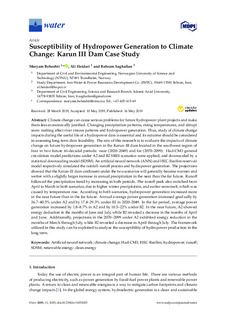| dc.contributor.author | Beheshti, Maryam | |
| dc.date.accessioned | 2019-06-03T08:13:25Z | |
| dc.date.available | 2019-06-03T08:13:25Z | |
| dc.date.created | 2019-05-31T10:59:36Z | |
| dc.date.issued | 2019 | |
| dc.identifier.citation | Water. 2019, 11 (5), 1025 | nb_NO |
| dc.identifier.issn | 2073-4441 | |
| dc.identifier.uri | http://hdl.handle.net/11250/2599626 | |
| dc.description.abstract | Climate change can cause serious problems for future hydropower plant projects and make them less economically justified. Changing precipitation patterns, rising temperatures, and abrupt snow melting affect river stream patterns and hydropower generation. Thus, study of climate change impacts during the useful life of a hydropower dam is essential and its outcome should be considered in assessing long-term dam feasibility. The aim of this research is to evaluate the impacts of climate change on future hydropower generation in the Karun-III dam located in the southwest region of Iran in two future tri-decadal periods: near (2020–2049) and far (2070–2099). Had-CM3 general circulation model predictions under A2 and B2 SRES scenarios were applied, and downscaled by a statistical downscaling model (SDSM). An artificial neural network (ANN) and HEC-ResSim reservoir model respectively simulated the rainfall–runoff process and hydropower generation. The projections showed that the Karun-III dam catchment under the two scenarios will generally become warmer and wetter with a slightly larger increase in annual precipitation in the near than the far future. Runoff followed the precipitation trend by increasing in both periods. The runoff peak also switched from April to March in both scenarios, due to higher winter precipitation, and earlier snowmelt, which was caused by temperature rise. According to both scenarios, hydropower generation increased more in the near future than in the far future. Annual average power generation increased gradually by 26.7–40.5% under A2 and by 17.4–29.3% under B2 in 2020–2049. In the far period, average power generation increased by 1.8–8.7% in A2 and by 10.5–22% under B2. In the near future, A2 showed energy deduction in the months of June and July, while B2 revealed a decrease in the months of April and June. Additionally, projections in the 2070–2099 under A2 exhibited energy reduction in the months of March through July, while B2 revealed a decrease in April through July. The framework utilized in this study can be exploited to analyze the susceptibility of hydropower production in the long term. | nb_NO |
| dc.language.iso | eng | nb_NO |
| dc.publisher | MDPI | nb_NO |
| dc.rights | Navngivelse 4.0 Internasjonal | * |
| dc.rights.uri | http://creativecommons.org/licenses/by/4.0/deed.no | * |
| dc.title | Susceptibility of Hydropower Generation to Climate Change: Karun III Dam Case Study | nb_NO |
| dc.type | Journal article | nb_NO |
| dc.type | Peer reviewed | nb_NO |
| dc.description.version | publishedVersion | nb_NO |
| dc.source.volume | 11 | nb_NO |
| dc.source.journal | Water | nb_NO |
| dc.source.issue | 5 | nb_NO |
| dc.identifier.doi | https://doi.org/10.3390/w11051025 | |
| dc.identifier.cristin | 1701779 | |
| dc.description.localcode | © 2019 by the authors. Licensee MDPI, Basel, Switzerland. This article is an open access article distributed under the terms and conditions of the Creative Commons Attribution (CC BY) license (http://creativecommons.org/licenses/by/4.0/). | nb_NO |
| cristin.unitcode | 194,64,91,0 | |
| cristin.unitname | Institutt for bygg- og miljøteknikk | |
| cristin.ispublished | true | |
| cristin.fulltext | original | |
| cristin.qualitycode | 1 | |

